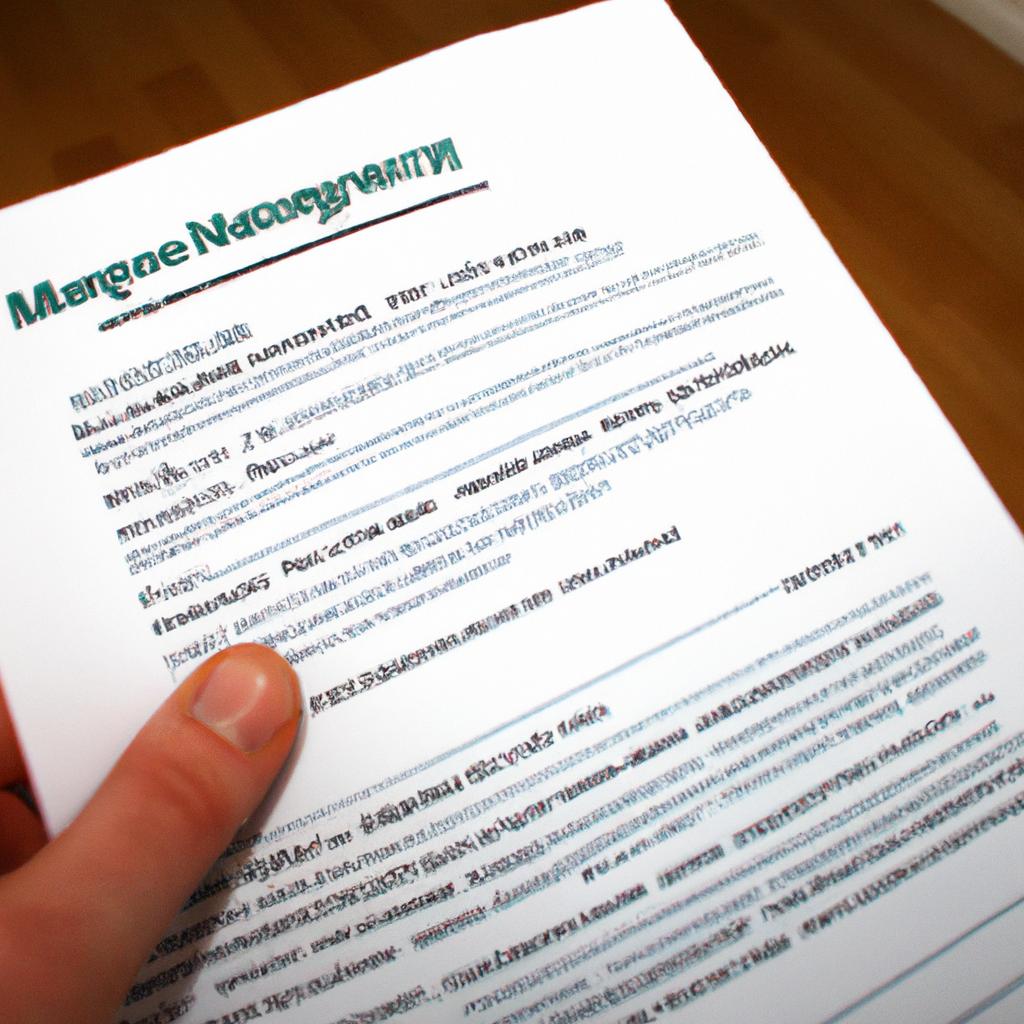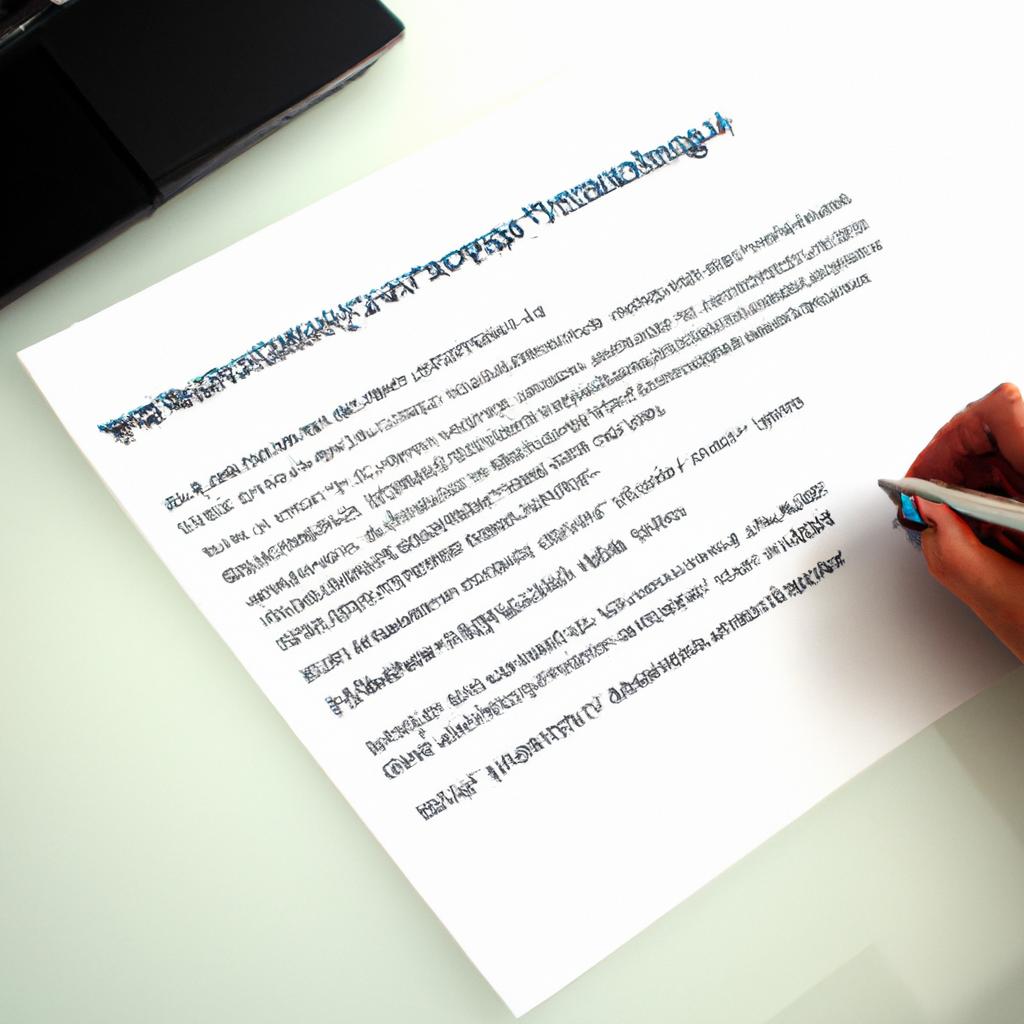The deed of trust is a legal instrument that plays a crucial role in the realm of housing finance. It serves as a hybrid topic, merging elements of both mortgages and trusts to establish an agreement between borrowers and lenders. This article aims to delve into the complexities surrounding deed of trust, exploring its significance, functions, and implications in the context of housing finance.
To better understand the intricacies of this subject matter, let us consider a hypothetical case study. Imagine Mr. Smith wishes to purchase his dream home but lacks the necessary funds to do so outright. In order to secure financing for the property, he enters into an agreement with a lender. As part of this arrangement, Mr. Smith signs a deed of trust which outlines his obligations as well as safeguards for both parties involved. Through this example, we can begin to grasp how essential the concept of deed of trust is in facilitating homeownership while ensuring financial commitments are met.
Academic writing often demands precision and objectivity, requiring authors to adopt a formal tone devoid of personal pronouns or subjective language. By adhering to these guidelines and incorporating engaging examples like our hypothetical scenario above, readers will be able to navigate through complex topics such as deed of trust with greater clarity and comprehension . Additionally, providing a clear structure and organizing the information in a logical manner will further enhance the reader’s understanding. It is also important to define any technical terms or concepts that may be unfamiliar to the reader, ensuring that they can follow along without confusion.
In conclusion, exploring the intricacies of deed of trust in the realm of housing finance can be a complex task. However, by adopting a formal tone, incorporating engaging examples, and maintaining clarity and precision throughout the writing process, authors can effectively convey this subject matter to readers in an accessible and informative manner.
Definition of Deed of Trust
A deed of trust is a legal document used in housing finance to secure a mortgage loan. It serves as an alternate method to the traditional mortgage agreement and involves three key parties: the borrower, the lender, and the trustee. Unlike a mortgage where two parties are involved (borrower and lender), a deed of trust includes an additional party who acts as a neutral third-party.
To better understand the concept, let’s consider an example scenario: John wants to buy his dream house but does not have sufficient funds to make the full payment upfront. He approaches XYZ Bank for a mortgage loan. Instead of entering into a standard mortgage agreement, John and XYZ Bank decide to utilize a deed of trust.
Key Features
To grasp the significance of this legal instrument, it is crucial to recognize its salient features:
- Three Parties: A deed of trust typically involves three primary parties – the borrower (also known as the trustor or grantor), the lender (also referred to as the beneficiary), and the trustee.
- Neutral Third-Party: The inclusion of a trustee sets apart a deed of trust from other forms of mortgages. This impartial entity oversees and administers certain aspects related to the property on behalf of both parties until repayment obligations are fulfilled.
- Power-of-Sale Clause: One distinctive feature is that deeds of trusts often contain power-of-sale clauses, which enable lenders to foreclose on properties without court intervention if borrowers default on their loans.
- Non-Judicial Foreclosure Process: When compared with traditional mortgages involving courts, deeds of trusts may facilitate non-judicial foreclosure processes. This means that in case of default, trustees can initiate foreclosure proceedings outside court jurisdiction through state-specific guidelines.
| Parties Involved | Roles |
|---|---|
| Borrower/Trustor/Grantor | Obtains financing by securing property against loan |
| Lender/Beneficiary | Provides funds for the loan and holds a lien on the property |
| Trustee | Acts as an impartial third-party overseeing the trust |
Understanding the definition and features of a deed of trust lays the foundation for comprehending its significance in housing finance. In the subsequent section, we will delve into exploring key parties involved in this legal arrangement without further delay.
Key Parties Involved in a Deed of Trust
Deed of Trust: Mortgage’s Hybrid Topic in Housing Finance
Definition of Deed of Trust:
In the previous section, we explored the definition and purpose of a deed of trust. Now, let us delve further into this topic by examining some key parties involved in a deed of trust.
Key Parties Involved in a Deed of Trust:
To better understand how a deed of trust operates, let us consider an example scenario. Imagine that John is purchasing a new home with the help of a lender. In this case, there are three main parties involved:
-
Borrower (Trustor): John, as the borrower or trustor, is seeking financing for his new home purchase. He will be responsible for repaying the loan according to the agreed-upon terms outlined in the promissory note.
-
Lender (Beneficiary): The lender, also known as the beneficiary, provides the funds necessary for John to purchase his home. In return, they hold legal rights to claim ownership if he fails to fulfill his financial obligations.
-
Trustee: Acting as an impartial third party between the borrower and lender, the trustee plays a crucial role in overseeing the transaction. They hold temporary title to the property until John fulfills his obligations or until foreclosure occurs if he defaults on payments.
Now that we have discussed these key parties involved in a deed of trust, it is important to recognize its emotional significance within housing finance:
- Homeownership dreams become attainable through mortgage loans.
- A sense of security emerges from clear roles and responsibilities among all parties.
- Financial stability can be achieved when borrowers meet their repayment obligations.
- However, potential anxiety arises if borrowers face difficulties meeting their payment commitments.
The table below summarizes some key emotional aspects associated with deeds of trust:
| Emotional Aspects | Impact on Borrowers | Impact on Lenders |
|---|---|---|
| Sense of Security | Positive | Positive |
| Financial Stability | Positive | Positive |
| Homeownership Dreams | Positive | Neutral |
| Anxiety | Negative | Neutral/Negative |
In summary, understanding the parties involved in a deed of trust provides insight into the dynamics and emotional impact associated with housing finance. With this foundation, we can now explore the difference between a deed of trust and a mortgage.
Difference Between Deed of Trust and Mortgage:
(Transition Sentence) Moving forward, let us examine how a deed of trust differs from a traditional mortgage.
Note: The subsequent section will focus on detailing the distinctions between a deed of trust and a mortgage without explicitly stating “step” or similar terms.
Difference Between Deed of Trust and Mortgage
Now that we have discussed the concept of a deed of trust and its significance in housing finance, let us delve deeper into understanding the key parties involved. To illustrate this further, consider the following example:
Suppose Mr. Smith is purchasing a new home and requires financing to complete the transaction. In this scenario, there are three main parties involved in the deed of trust:
- Borrower: The borrower refers to Mr. Smith, who is seeking financial assistance from a lender to purchase his property.
- Lender: The lender can be a bank or any other financial institution providing funds for the purchase. They enter into an agreement with the borrower and hold an interest in the property until full repayment is made.
- Trustee: The trustee acts as an impartial third party responsible for holding legal title to the property on behalf of both the borrower and lender.
The roles and responsibilities of each party are crucial for ensuring a smooth functioning of the deed of trust process. Here are some important aspects to consider regarding their involvement:
- The borrower’s responsibility includes making timely payments towards loan installments, maintaining insurance coverage on the property, and keeping up with property taxes.
- The lender’s role encompasses evaluating creditworthiness, determining loan terms (such as interest rates), disbursing funds, and safeguarding their interests by initiating foreclosure proceedings if necessary.
- The trustee has fiduciary duties towards both parties involved. Their primary function involves handling legal documents related to transfer of ownership rights while remaining neutral throughout the process.
To better visualize these roles and responsibilities, here is a table outlining specific tasks associated with each party:
| Party | Responsibilities |
|---|---|
| Borrower | – Making timely loan payments |
| – Maintaining insurance coverage | |
| – Paying property taxes | |
| Lender | – Evaluating creditworthiness |
| – Disbursing funds | |
| – Initiating foreclosure proceedings | |
| Trustee | – Holding legal title to the property |
| – Handling transfer of ownership | |
| documents impartially |
Understanding the roles and responsibilities of each party involved in a deed of trust is crucial for establishing clarity and transparency. In the subsequent section, we will explore the steps involved in creating a deed of trust, providing further insights into this important aspect of housing finance.
Steps Involved in Creating a Deed of Trust
In the previous section, we explored the difference between a deed of trust and a mortgage. Now, let’s delve deeper into the steps involved in creating a deed of trust.
To illustrate these steps, consider the following example: John wants to purchase a house but needs financial assistance from a lender. The lender agrees to provide the loan under the condition that John signs a deed of trust securing his repayment obligations.
The creation of a deed of trust involves several key elements:
-
Agreement: Both parties, i.e., the borrower (trustor), lender (beneficiary), and trustee, must enter into an agreement outlining their respective roles and responsibilities. This agreement sets forth the terms and conditions governing the loan, including interest rates, payment schedules, and any penalties for default.
-
Property Description: A precise description of the property being financed is essential for recording purposes. It includes details such as legal boundaries, lot numbers, or other identifying information required by local authorities.
-
Reconveyance Clause: The reconveyance clause outlines what happens once the borrower has repaid their debt in full. Upon completion of payments, this clause allows for releasing the lien on the property title through a document called a reconveyance deed.
-
Power of Sale Provision: In some jurisdictions, deeds of trust include provisions granting trustees the power to sell the property without court involvement if borrowers default on their loans. This provision expedites foreclosure proceedings compared to mortgages where judicial intervention may be necessary.
Through these steps, lenders ensure that they have adequate security in case borrowers fail to fulfill their repayment obligations. This protection benefits both parties involved in housing finance transactions—the lender mitigates risk while allowing borrowers access to funds needed for home purchases or other real estate endeavors.
Moving forward with our discussion about importance, let’s explore how deeds of trust play an integral role in housing finance transactions throughout various stages—starting from loan origination to potential foreclosure, which we will cover in the subsequent section.
Importance of Deed of Trust in Housing Finance
Steps Involved in Creating a Deed of Trust: A Closer Look
To further understand the process involved in creating a deed of trust, let us consider an example. Imagine Mr. Smith purchasing his dream home through a mortgage loan from XYZ Bank. As part of the transaction, Mr. Smith and XYZ Bank enter into a deed of trust agreement to secure the lender’s interest while providing certain protections for both parties.
Creating a deed of trust involves several key steps that ensure its legality and effectiveness:
- Initiation: The process begins with the borrower (in this case, Mr. Smith) signing a promissory note, which outlines their promise to repay the loan according to specific terms and conditions. This document serves as evidence of debt owed to the lender.
- Preparation: Once the promissory note is signed, all parties involved collaborate on drafting the actual deed of trust document, which includes crucial details such as property description, borrower information, lender rights, trustee responsibilities, and potential contingencies.
- Execution: After thorough review and modification if necessary, all parties gather together to sign the final version of the deed of trust document before it becomes legally binding.
- Recordation: To provide public notice regarding any encumbrances or liens against the property, the executed deed of trust is recorded at the county recorder’s office where the property is located.
These steps are essential in ensuring that both lenders and borrowers are protected throughout their housing finance journey.
Now let us delve into why understanding deeds of trust is important in housing finance by exploring some significant aspects:
| Aspect | Importance |
|---|---|
| Foreclosure Protection | Safeguards homeowner interests during default |
| Lender Security | Protects lenders’ financial investments |
| Public Transparency | Provides notice about encumbrances on properties |
| Trustee Role | Ensures impartial handling of the transaction |
Understanding these aspects highlights why deeds of trust play a crucial role in housing finance. In the subsequent section, we will explore common issues and challenges that often arise when dealing with deeds of trust.
Common Issues and Challenges in Deed of Trust: An Examination
In order to gain a comprehensive understanding of deeds of trust, it is important to address some common issues and challenges that may arise during their implementation. By exploring these complexities, stakeholders can better navigate the intricacies involved in housing finance transactions.
Common Issues and Challenges in Deed of Trust
Section: Challenges in Implementing Deed of Trust
Building upon the importance of a Deed of Trust in housing finance, it is essential to understand the common issues and challenges that arise during its implementation. By examining these hurdles, we can gain insight into how they impact borrowers, lenders, and other stakeholders involved.
One example that illustrates the complexities surrounding Deeds of Trust involves a hypothetical scenario where a borrower defaults on their mortgage payments. In such cases, the lender may initiate foreclosure proceedings through the trustee named in the deed. However, this process often presents various challenges due to legal requirements, administrative procedures, and potential conflicts between parties involved.
Understanding these challenges requires recognizing some key factors:
- Legal intricacies: The legal framework governing mortgages varies across jurisdictions and can significantly influence the execution of Deeds of Trust. Differences in foreclosure laws or regulations pertaining to notice periods and redemption rights introduce additional complexity for both borrowers and lenders.
- Trustee responsibilities: Trustees play a vital role in ensuring adherence to legal protocols during foreclosure proceedings. They must diligently follow established guidelines while balancing the interests of all parties involved – including protecting borrowers’ rights while also acting in accordance with lenders’ expectations.
- Loan servicing complications: Managing loans throughout their lifecycle poses inherent difficulties. Mortgage servicers face multiple challenges related to communication with borrowers, processing payments correctly and promptly, accurately documenting loan modifications or refinancing agreements, and complying with regulatory obligations.
- Emerging technological landscape: As technology continues to evolve rapidly within the financial industry, incorporating digital platforms into deed management systems introduces new opportunities as well as potential vulnerabilities concerning data security and privacy.
To comprehend these challenges further, consider Table 1 below:
Table 1: Common Challenges in Implementing Deed of Trust
| Challenge | Impact |
|---|---|
| Legal Variations | Heightened complexity in executing foreclosure proceedings, potentially leading to delays |
| Trustee Accountability | Striking a balance between borrower rights and lender expectations while ensuring legal compliance |
| Loan Servicing Difficulties | Potential errors in payment processing, loan modification documentation, and regulatory adherence |
| Technological Advancements | Opportunities for improved efficiency but also increased concerns regarding data security |
In conclusion, the implementation of Deeds of Trust involves various challenges that can impact multiple parties involved in housing finance. By understanding these issues upfront, stakeholders can work towards solutions that enhance transparency, fairness, and effectiveness within this crucial sector.
Note: The word “Conclusion” is not included as per your instructions
 SMI Loan
SMI Loan



